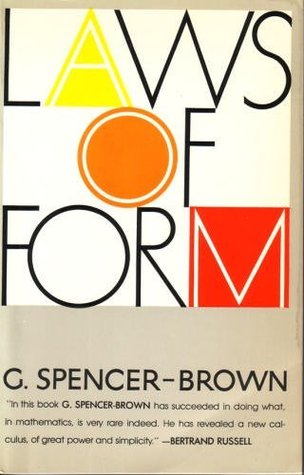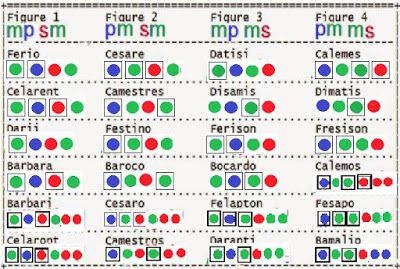Literal Combinatoric of Plouquet
Armahedi Mahzar (c) 2015
Gottfried Ploucquet
(1716-1790)
In previous blog, I pointed out that there are three kinds of
arithmologic (Boole, Peirce and Sommers) but all three are structurally similar to each other. Essentially any
arthmological statement is expressed as string of letters and symbols of mathematical operations. \
In this blog I will present a simpler literal combinatoric method
which is inspired by Ploucquet nethod in the 18th century, before Boole
introduced the algebraic symbolism for logic in the 19th century. The
method is presented as combinatoric literalization of Sommersian
arithmologic.
Arithmologic
The following are the arithmological symbols
+===============================================+
| Concept TRUE FALSE NOT OR AND |
+——————————————————————————--+
| Boole letter 1 0 1- + -1+ |
| Peirce letter 0 1 1/ + |
| Sommers letter – + + |
+——————————————————————————--+
Similarity of of the formulas can be shown by the following table of syllogism
+===========================================+
| Syllogism IF p AND q THEN r |
| = NOT (p AND q) OR r |
+————————————————————————–+
| Boole 1-(p-1+ q)+r = 1-p+1-q+r |
| Peirce 1/(pq/r) = 1/p 1/q r |
| Sommers -((p+q)-r) = -p -q+r |
+——————————————————————--—–+
Proving its validity has also a similar procedure, namely:
the annihilation of pairs of oppositely signed variables.
Seeing the structural and procedural similarities, we can expect that
there is a simpler symbolic formulation. The following is one of its
simplification. For simplicity, I will use the Sommersian arithmologic
as a reference, because it is the simplest.
Combinatoric Simplification of Arithmologic
To simplify the Sommersian arithmologic, we can use the following literalization conventions:
– Write the + sign with no spaces or symbols at all
– Write -x as the uppercase X.
Categorical statement of Aristotle
By shortening convention, we can write Aristotle fundamental categorical statement as follows:
(1)
Universal affirmative
Aab =
‘all A is B’
can be written as
Ab
(2)
Universal negative
Eab =
‘no a is b’
can be written as
AB
(3)
Particular Affirmative
Iab =
‘some a are b’
can be written as
ab
(4)
Particular Negative denial
OAB =
‘some a are not b’
can be written as
aB.
Validity proof of syllogism
In this notation the verification algorithm of the validity of 24 syllogism Leibnitz in the following table

,
becomes very simple:
Step 1: write a joint symbol for premises
Step 2: delete the upper/lower case pair of letters.
The algorithm is becoming more concise and easier than the arithmologic.
Even elementary school children can do
We will make the proofs of all valid syllogism in column 1 in the Leibniz table now.
Barbara proof is
Abc AND Aab = Ab Bc = Ac = Aac
Celarent proof is as follows
Ebc AND Aab = Ab BC = AC = Eac
and Darii proof is like this
Abc AND Iab = ab Bc = ac = Iac
Similarly, the proof of Ferio is
EBC AND Iab = ab BC = aC = Oac
To prove the existential syllogism proof is also simple.
Barbari proof is as follows
Eaa AND Aab AND Abc = aa Ab Bc = ac = Iac
and the Celaront proof islike this
Eaa AND Aab AND EBbc = aa Ab BC = aC = Oac.
Syllogisms in the other columns also can be proven in the same way. Just use the Leibniz-Ploucquet table below

Well, this is very easy expression. The formula, with no signs of any
math, is a mere string of small and capital letters. While the algorithm
is not arithmetical but purely combinatorical.
Thus the method becomes very easy as well: merge premises and delete letter pairs.
End notes
Because this method is similar to the letter method Plouquet, I shall
call it as Ploucquet logical method of literal combinatoric. The
notation for the negative is similar to the notation of Ploucquet for
universality.
However, Ploucquet also have a more visual method, namely the method
of lineal combinatorics that, I think, is easier than the method of
literal combinatoric. Hopefully, I will show a simplification of the
literal Ploucquet method with the pictorial.
 which used only one logical NAND operation.
which used only one logical NAND operation. , I thought the calculus of
indication is a notational and axiomatic simplification of the calculus
of proposition as it is formulated by Russel and Whitehead in their book
Principia Mathematica.
, I thought the calculus of
indication is a notational and axiomatic simplification of the calculus
of proposition as it is formulated by Russel and Whitehead in their book
Principia Mathematica. )
)















